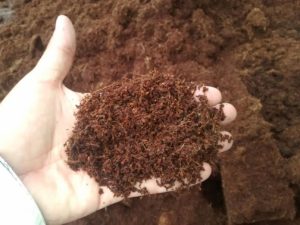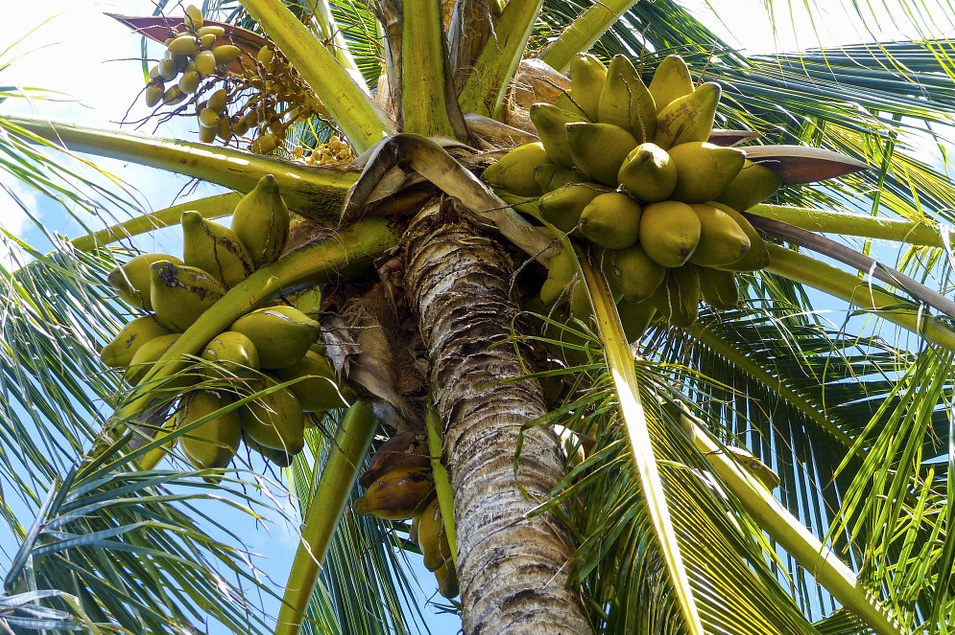Coco Coir – Yet Another Gift From the Coconut Palm
“Coir” is a soil type growing media that comes from coconuts, specifically the husk. The story of coir and how it was discovered as a growing media dates back to 1940 when a soil scientist, EP Hume, noted that “dust” created from extracting long fibers from the coconut husk, had properties similar to peat moss. Fascinated by this, Hume dubbed it “coco peat” and began experimentation with it as a growing media.

Today, coir is increasingly used worldwide as a preferred growing media for large scale greenhouse cultivation of food, and ornamental plants. Can coir benefit home gardens and container grown plants? Yes!
Knowing that coir has a significant place within the world’s growing community, one can respect that intense study has deemed coir as a choice growing medium. These studies have resulted not only in acceptance but embracing the use of coco peat in pro environments. For home and smaller scale growers, one can feel comfortable knowing that through study, coir has passed many tests of suitability.
Qualities of Coco Coir that Growers Appreciate
Growers appreciate many qualities that coir possesses, but these “bonuses” are in addition to its material properties:
- Coir is an organic medium
- Coir is a renewable resource
- Coir is eco-friendly
In terms of physical and chemical properties of coir, here are the notables:
Moisture Retention and Drainage
When examined through a microscope one sees that coir fibers are made up of tiny hollow tubes. When water is added to dry coir, these tubes fill up rapidly and hold the water. When the tubes are full, no more water can be held, so excess water drains right through. This draining action sucks in oxygen from the air and distributes it through the substrate. In addition, coir is considered “hydrophoric”. The word hydrophoric comes from the Greek “hydrophoria” meaning “water carrier” and is the opposite of hydrophobic, which means “lacking affinity” for water.
Neutral pH
The Old Farmers Almanac states that “A pH of
6.5 is just about right for most home gardens, since most plants thrive in the
6.0 to 7.0 (slightly acidic to neutral) range. Some plants (blueberries, azaleas) prefer more strongly acidic soil, while a few (ferns, asparagus) do best in soil that is neutral to slightly alkaline.”
The pH of Coir ranges between 5.5 and 6.5 and is extremely suitable for plants. Should you be growing a crop that prefers a higher or lower pH, it can be corrected with additives.
Electrical Conductivity or “EC”
EC measures the amount of salt and nutrients present in a substrate. With coir, salt can be a concern and it’s important that when purchasing a coir product, you choose one with an EC level less than .8. This is usually mentioned on the packaging. Higher EC products can be used if rinsed with water before use. Many coir producers offer both low EC and High EC product as some growers prefer to wash their own coir with the irrigation they have in place. Low EC coir is ready to use and grow.
Inert
Coir is has very few nutritional qualities. Lesser amounts of Iron and Manganese and Potassium are generally present but not many other nutrients. For hydroponic growers this is good thing because many growers want to tailor a specific blend of nutrients for desired results.
Using coir in garden beds and containers requires added nutrients. Some people accomplish this by blending coir with compost or other amendments to naturally add necessary nutrients, others use it at 100% levels and just add desired fertilizers through drip, controlled release or conventional fertilizers.
Structure
The structure and texture of coir can vary depending on percentages of coir “pith” to fiber and chips. The typical 5kg coir block will contain mostly coir pith (small particles) and some fiber. When expanded into it’s full volume of approximately 2.5 cu ft, it will be light, fluffy and airy, in a pleasing warm brown color. This texture is one of the reasons coir is so popular. If it’s squeezed, the water holding capacity is apparent; water will squeeze right out of it, just like squeezing a sponge.
Coir as a Soil Amendment
Coir is a fantastic soil amendment. According to an old experiment performed by Hume and his research assistants, adding only 2 percent of coco peat to sandy soil, increased the water holding capacity by 40%. It works as well in reverse too. Heavy clay soils amended with Coir will become less dense and friendlier to root penetration with better drainage.
Adding various components like bark, compost, coco chips (pieces of husk cut into chips) etc are often used to add texture for to coir for container growing.
Re-Usable and Compostable
Coir is a long-lasting product due to high lignin content of its components. It takes years for it to break down. It can be reused as desired and as an organic product, is completely compostable.
Using Coir
Coir is usually is purchased in compressed form. Compression is used for lowering costs of transporting coir from the main coir belts of the world, most of which are located in Asia, specifically India, and Sri Lanka. Hydraulic machinery is used to squeeze the dry coir down to a fraction of its size when dry and loose.
Coir “blocks” measure about 12x12x6 inches and weigh 11 lbs. These blocks are compressed 5 to 1. When water is added these “5kg” blocks will expand to 2 to 2.5 cu ft of growing media, enough to fill a wheelbarrow. It is easy and fun to expand coir blocks. Place a block in a wheel barrel and slowly add approximately 5 gallons of water. The block will begin to expand as the water is added. As it expands push aside the expanded part to get to the dry parts underneath and just keep adding water and fluffing until expansion is complete. You can now use your coir to nurture existing soil, add to containers or mix in compost or additives.
Coir “Bricks” are also popular. They look just like a brick, weigh about 1.5 lbs and expand to 2 gallons or more of growing media. Expansion is the same: add water and fluff.
Coco coir blocks and bricks are easy to store and use for whatever potting project may arise. You’ll also notice coir products in compressed discs for seed starting and grow bags that come prefilled with a compressed brick sized for the bag.
For soil amendment, place bricks or blocks in the area to nurture, hand water or put sprinklers on them until they expand and break apart. Then simply work the expanded coir into the soil.
Buying Coir
Ready to try coco coir? You’ll find that Coir is sold under many brand names. Common names include coir, coco coir, coco peat, and just plain coco. You should be able to find it at garden centers and big box stores. Amazon also has coir products and with prime shipping, is always a good bet. If you can’t find it in your local big box stores, your local hydroponic retailer will be sure to have it in block form, brick form and pre-expanded in bags. Coir is also found in many ready to use commercial bagged garden soil products.
As your growing season starts this year, give this fluffy growing media a try and discover for yourself all the qualities of amazing coco peat.
 Today, coir is increasingly used worldwide as a preferred growing media for large scale greenhouse cultivation of food, and ornamental plants. Can coir benefit home gardens and container grown plants? Yes!
Knowing that coir has a significant place within the world’s growing community, one can respect that intense study has deemed coir as a choice growing medium. These studies have resulted not only in acceptance but embracing the use of coco peat in pro environments. For home and smaller scale growers, one can feel comfortable knowing that through study, coir has passed many tests of suitability.
Today, coir is increasingly used worldwide as a preferred growing media for large scale greenhouse cultivation of food, and ornamental plants. Can coir benefit home gardens and container grown plants? Yes!
Knowing that coir has a significant place within the world’s growing community, one can respect that intense study has deemed coir as a choice growing medium. These studies have resulted not only in acceptance but embracing the use of coco peat in pro environments. For home and smaller scale growers, one can feel comfortable knowing that through study, coir has passed many tests of suitability.

